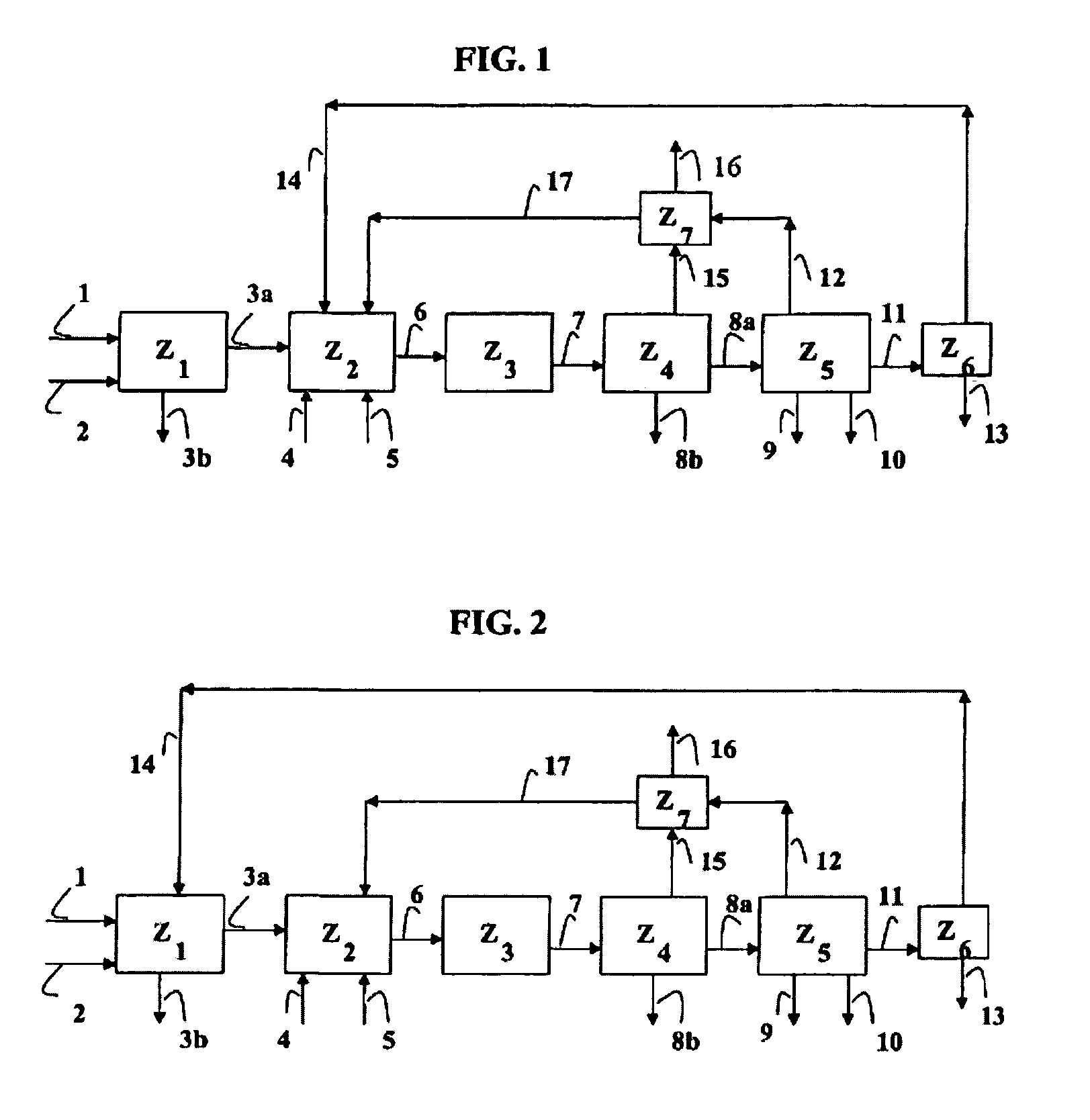Production of liquid fuels by a concatenation of processes for treatment of a hydrocarbon feedstock
a hydrocarbon feedstock and process technology, applied in the direction of gasification process details, inorganic chemistry, combustible gas production, etc., can solve the problems of limited economic advantage, achieve maximum carbon conversion, reduce or upgrade naphtha, and limit costly adjustments
- Summary
- Abstract
- Description
- Claims
- Application Information
AI Technical Summary
Benefits of technology
Problems solved by technology
Method used
Image
Examples
example 1
[0079]This example is based on the computer modeling of a concatenation of processes for conversion of biomass into synthesis gas then conversion of said synthesis gas into liquid fuels according to FIG. 1, with the exception of the recycling of top gas and the recycling of naphtha produced in the separation zone, which are not carried out. In other words, the flow rates of streams 14 and 17 are zero. The modeling was carried out by the Pro II® software marketed by the SIMSCI Company.
[0080]Calculations are carried out for an installation that has a 50-ton capacity per hour of dry-base biomass, operating at 0.4 MPa (megapascals). The biomass corresponds to sawdust whose solid particles have a diameter of between 1 and 4 mm and a ratio of length to diameter, L / D, of between 1 and 3. The biomass is introduced in the presence of a conveying gas that corresponds to the combustion fumes that consist of nitrogen and carbon dioxide.
[0081]The biomass is introduced into gasification zone Z1 w...
example 2
[0090]A computer simulation is carried out based on Example 1, with the exception of the top gas that is produced in Fischer-Tropsch section Z4, which is recycled at the inlet of secondary gasification zone Z2 with a purge level of 15% so as to avoid excessive accumulations of nitrogen in the synthesis gas loop. The cumulative production of gas oil and kerosene is 9550 kg / hour, or a yield of 19.1% by weight of dry-base biomass.
[0091]Table No. 2 below sums up the various flows of the process concatenation.
[0092]
TABLE 2Flux en kg / hr123a3b45678a8bBiomasse sèche50000N250070500700032175321881300H20282255908057CO0196394558037442CO21679024695186342691H2O35523287642317237124049Goudrons0176Résidus carbonés6898CH404598C2–C4C5–C93581C10–C143189C15–C196351TOTAL568863552385701670900123652807491325124049Flux en kg / hr91011121314151617Biomasse sècheN20001300032058501927168H2054882466CO1639304503349CO26433283002829H2O46136571114Goudrons0000Résidus carbonésCH41815902451363C2–C43001847443.81871.1C5–C9...
example 3
According to the Invention
[0094]A computer simulation is carried out based on Example 1, with the exception of the top gas that is produced in Fischer-Tropsch section Z4, which is recycled at the inlet of secondary gasification zone Z2. It is the same for the naphtha that is produced in final separation zone Z5 of the liquid fuels. The purge levels are respectively 15% on the top gas and 1% on the naphtha so as to prevent excessive accumulations of undesirable products in the synthesis gas loop. The cumulative production of gas oil and kerosene is 12,504 kg / hour, or a yield of 25.0% by weight of dry-base biomass.
[0095]Table No. 3 below sums up the various flows of the process concatenation.
[0096]
TABLE 3Flux on kg / hr123a3b45678a8bBiomasse sèche50000N2500705007000321753217600H20262274337931CO0196395861151643CO21879024895171832613H2O35623287641609145130754Goudrons0175Résidus carbonés6699CH404598C2–C4C5–C94689C10–C144175C15–C198329TOTAL568863552385701670800131495850241719530754Flux on ...
PUM
| Property | Measurement | Unit |
|---|---|---|
| temperature | aaaaa | aaaaa |
| temperature | aaaaa | aaaaa |
| temperature | aaaaa | aaaaa |
Abstract
Description
Claims
Application Information
 Login to View More
Login to View More - R&D
- Intellectual Property
- Life Sciences
- Materials
- Tech Scout
- Unparalleled Data Quality
- Higher Quality Content
- 60% Fewer Hallucinations
Browse by: Latest US Patents, China's latest patents, Technical Efficacy Thesaurus, Application Domain, Technology Topic, Popular Technical Reports.
© 2025 PatSnap. All rights reserved.Legal|Privacy policy|Modern Slavery Act Transparency Statement|Sitemap|About US| Contact US: help@patsnap.com

